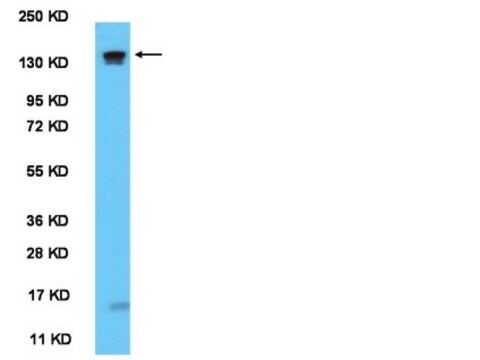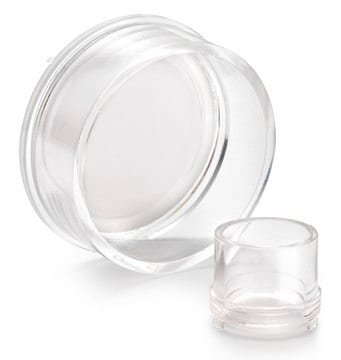About This Item
Código UNSPSC:
12352203
eCl@ss:
32160702
NACRES:
NA.41
Produtos recomendados
fonte biológica
rabbit
Nível de qualidade
forma do anticorpo
serum
tipo de produto de anticorpo
primary antibodies
clone
polyclonal
reatividade de espécies
mouse, human, rat
fabricante/nome comercial
Chemicon®
técnica(s)
western blot: suitable
nº de adesão GenBank
Condições de expedição
wet ice
modificação pós-traducional do alvo
unmodified
Informações sobre genes
mouse ... Clock(12753)
Descrição geral
Circadian Locomotor Output Cycles Kaput, or Clock is a gene which encodes proteins regulating circadian rhythm. This gene encodes a protein that belongs to the basic helix-loop-helix (bHLH) family of transcription factors. Polymorphisms within the encoded protein have been associated with circadian rhythm sleep disorders. A similar protein in mice is a circadian regulator that acts as a transcription factor and forms a heterodimer with aryl hydrocarbon receptor nuclear translocator-like protein to activate transcription of mouse period 1.
Especificidade
Cat. # AB2203 recognizes CLOCK protein
Reactivity with other species has not been tested.
Aplicação
Anti-CLOCK Antibody is an antibody against CLOCK for use in WB.
Western Blot Analysis:
L6 lysate was resolved by electrophoresis, transferred to PVDF membrane and probed with anti-CLOCK (1:500 dilution of this lot).
Proteins were visualized using a Donkey anti-rabbit secondary antibody conjugated to HRP and a chemiluminescence detection system.
L6 lysate was resolved by electrophoresis, transferred to PVDF membrane and probed with anti-CLOCK (1:500 dilution of this lot).
Proteins were visualized using a Donkey anti-rabbit secondary antibody conjugated to HRP and a chemiluminescence detection system.
Qualidade
Routinely evaluated by western blot on L6 tissue lysate.
Descrição-alvo
Approx. 95 kDa
Nota de análise
Control
L6 Cell Lysate.
L6 Cell Lysate.
Outras notas
Concentration: Please refer to the Certificate of Analysis for the lot-specific concentration.
Informações legais
CHEMICON is a registered trademark of Merck KGaA, Darmstadt, Germany
GenBank is a registered trademark of United States Department of Health and Human Services
Not finding the right product?
Try our Ferramenta de seleção de produtos.
Código de classe de armazenamento
10 - Combustible liquids
Classe de risco de água (WGK)
WGK 1
Certificados de análise (COA)
Busque Certificados de análise (COA) digitando o Número do Lote do produto. Os números de lote e remessa podem ser encontrados no rótulo de um produto após a palavra “Lot” ou “Batch”.
Já possui este produto?
Encontre a documentação dos produtos que você adquiriu recentemente na biblioteca de documentos.
Antibodies for assessing circadian clock proteins in the rodent suprachiasmatic nucleus.
LeSauter, J; Lambert, CM; Robotham, MR; Model, Z; Silver, R; Weaver, DR
Testing null
Xiaoqin Liu et al.
PloS one, 7(11), e50602-e50602 (2012-11-29)
Circadian rhythms in metabolism, physiology, and behavior originate from cell-autonomous circadian clocks located in many organs and structures throughout the body and that share a common molecular mechanism based on the clock genes and their protein products. In the mammalian
Yohei Kobayashi et al.
Neuron, 86(1), 264-275 (2015-03-25)
Circadian rhythms control a variety of physiological processes, but whether they may also time brain development remains largely unknown. Here, we show that circadian clock genes control the onset of critical period plasticity in the neocortex. Within visual cortex of
Mark A Naven et al.
Theranostics, 12(8), 3963-3976 (2022-06-07)
The circadian clock in murine articular cartilage is a critical temporal regulatory mechanism for tissue homeostasis and osteoarthritis. However, translation of these findings into humans has been hampered by the difficulty in obtaining circadian time series human cartilage tissues. As
Arthur H Cheng et al.
Cell reports, 26(12), 3191-3202 (2019-03-21)
Clock neurons within the mammalian suprachiasmatic nuclei (SCN) encode circadian time using interlocked transcription-translation feedback loops (TTFLs) that drive rhythmic gene expression. However, the contributions of other transcription factors outside of the circadian TTFLs to the functionality of the SCN
Nossa equipe de cientistas tem experiência em todas as áreas de pesquisa, incluindo Life Sciences, ciência de materiais, síntese química, cromatografia, química analítica e muitas outras.
Entre em contato com a assistência técnica








